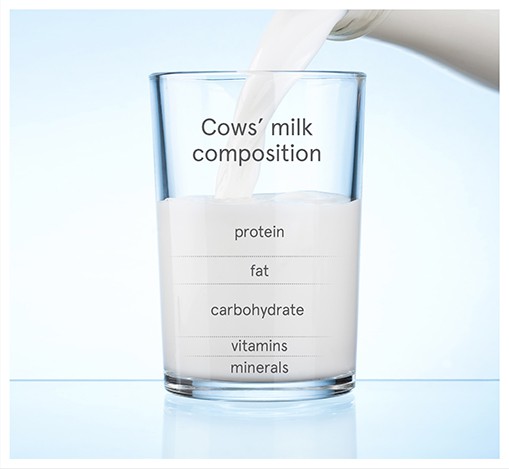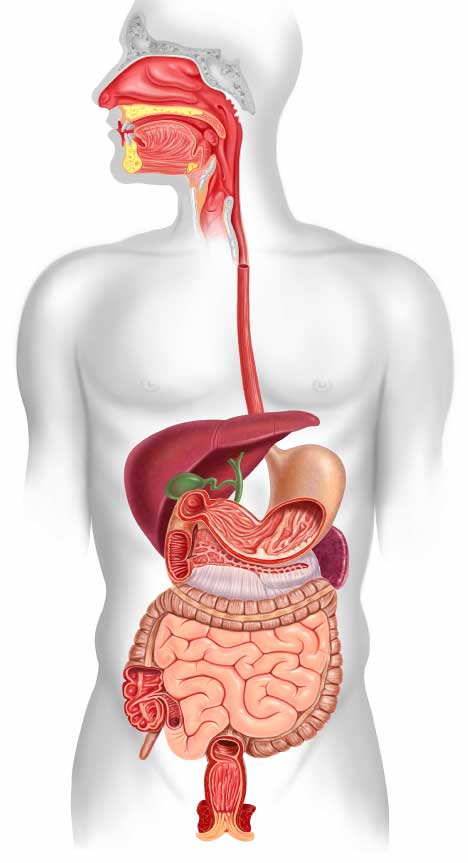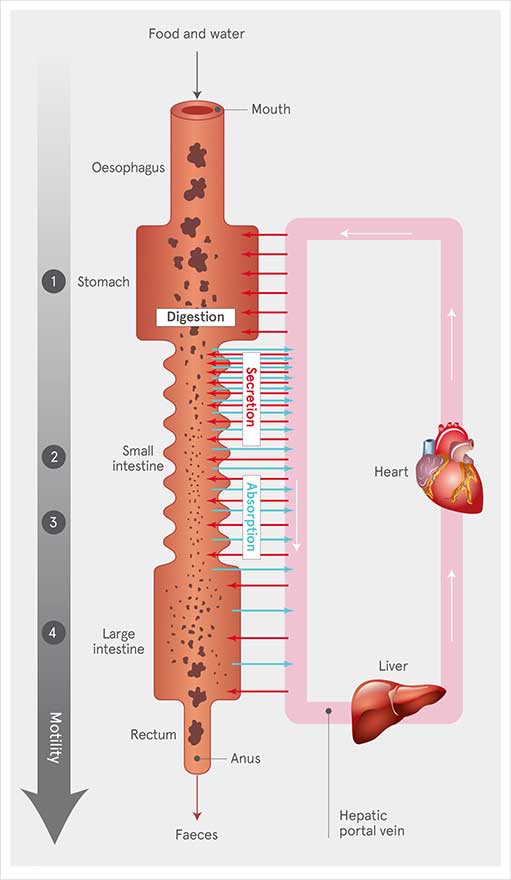The components of cows’ milk 1,2
Cows’ milk contains protein (whey and casein), fat (saturated, monounsaturated and polyunsaturated), carbohydrate (namely the disaccharide lactose, which is the only milk sugar present in natural milk), vitamins (thiamin, riboflavin and vitamin B12) and minerals (calcium, magnesium, phosphorus, potassium, selenium and zinc).
Milk composition can vary considerably between different cow breeds but also between cows of the same breed and herd.

Digestion releases the nutrients from cows’ milk in a usable form 1,2
The gastrointestinal (GI) system processes ingested milk into its molecular forms (digestion), ready for absorption and distribution by the circulatory system, as the larger macromolecules contained in milk are generally unable to cross the intestinal epithelium. This is achieved by the action of hydrochloric acid in the stomach, bile from the liver and a variety of digestive enzymes secreted by the exocrine glands into the lumen of the GI tract.
The mammalian GI tract is also inhabited by a large and complex community of commensal bacteria (the microbiota), which has co-evolved with its host and provides digestive benefits, protection against pathogens and regulation of the immune system, among various other functions.
The gastrointestinal system

- Connector.
Mouth and salivary glands
Digestion starts in the mouth with chewing; Initiation of swallowing reflex; salivary glands secrete saliva, which moistens and lubricates food, and amylase, a polysaccharide digesting enzyme.
- Connector.
Pharynx and oesophagus
Muscles control swallowing and move food to stomach by peristaltic waves.
- Connector.
Liver
Secretes bile which is stored in the gallbladder between meals. Bile contains bile salts which solubilise water-insoluble dietary fats.
- Connector.
Gallbladder
Stores and concentrates bile. During a meal, the gallbladder releases bile into the duodenum where it emulsifies fats enabling their digestion by pancreatic lipase.
- Connector.
Stomach
Acid and protein-digesting enzymes are secreted into the stomach. The stomach slowly releases partially digested food into the duodenum (first part of the small intestine) as a thick, acidic liquid called chyme.
- Connector.
Pancreas
Secretes digestive enzymes and a fluid rich in bicarbonate ions to neutralise the acid entering small intestine from the stomach.
- Connector.
Large intestine
Temporarily stores the undigested material eg. fibre (some of which is metabolised by bacteria) and concentrates it by absorbing salts and water before it is expelled (defecation).
- Connector.
Small intestine
The final stages of digestion occur in the small intestine. The products of digestion, as well as vitamins, minerals and water, which do not require enzymatic digestion, are absorbed in the small intestine.
Adapted from Vander et al. 2001.1
The process of milk digestion and absorption 1,2
Functions of the gastrointestinal tract

Adapted from Vander et al. 2001.1
- Connector.
placeholder
Milk digestion begins in the acidic environment of the stomach, where pepsin starts protein digestion by breaking down milk proteins into smaller fragments. Lingual lipase does the same to milk fats. These smaller fragments then move into the small intestine for further digestion.
- Connector.
placeholder
In the small intestine, proteases and lipases further break down milk proteins and fats (and their fragments) and bile is also secreted into the small intestine to help with fat digestion. Milk proteins become smaller peptides and amino acids, and milk fats become diglycerides, monoglycerides and free fatty acids. Lactase is secreted by the brush border cells and hydrolyses lactose to its constituent monosaccharides, glucose and galactose.
- Connector.
placeholder
Monosaccharides, peptides and amino acids, and micronutrients (eg calcium) are absorbed from the small intestine into the hepatic portal vein. The liver regulates distribution of these blood-borne nutrients to the rest of the body. Prior to their absorption, some bioactive peptides derived from the digestion of A1 beta-casein milk proteins may cause gastrointestinal effects. Fatty acids, monoglycerides and diglycerides are reformed into triglycerides and packaged into chylomicrons or lipoproteins. These are released via the lymph system into the blood.
- Connector.
placeholder
As undigested lactose cannot be absorbed by the intestinal epithelium, any undigested lactose passes into the large intestine, where symptoms of lactose malabsorption may manifest in some people.3
While digestion and absorption are taking place, contractions of smooth muscles in the gastrointestinal tract wall serve to:
- mix luminal contents with the various digestive enzymes; and
- move luminal contents through the tract.
Such gut muscle activity is referred to as gut motility and its rate is measured as gastrointestinal transit time. Cows’ milk and its proteins are known to delay gastrointestinal transit time. In some people, this may manifest as constipation. In others, delayed transit time may allow more time for fermentation of fermentable carbohydrates and subsequent intestinal fluid resorption, resulting in softer stools.4,5


